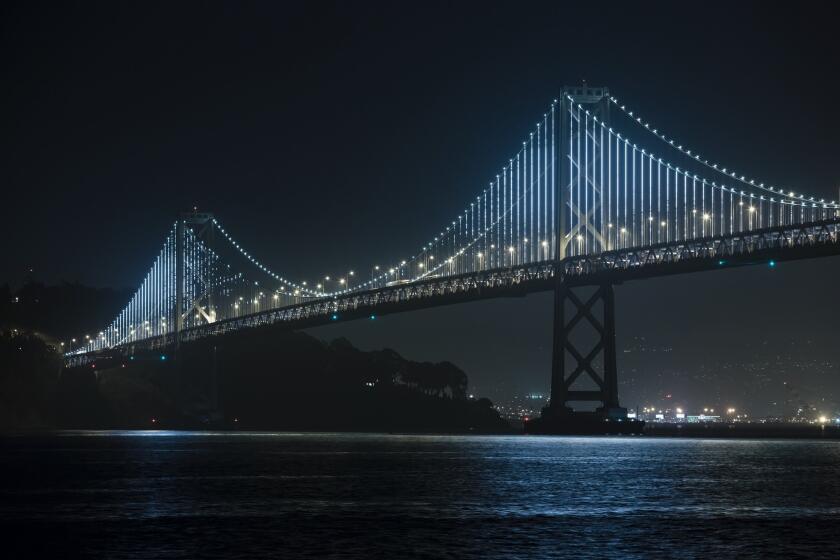Turning the corner at Hollywood and Vine
In the grand scheme of things, the fire that gutted a Hollywood nightclub Tuesday wasn’t that big a deal.
No lives were lost; nobody was injured. But the blaze dominated the day’s news. That’s what happens when something unusual occurs at what boosters have long called “the world’s most famous intersection.”
For 80 years the corner of Hollywood Boulevard and Vine Street has basked in a mystique that is equal parts glamour, gamble and gauche.
These days it’s the centerpiece of Los Angeles’ most ambitious redevelopment effort. Graceful 1920s-era office buildings have been spruced up and converted into housing, and a new luxury hotel and retail shops are being developed in a $1.2-billion mix of urban renewal and new construction.
That kind of combination has been a staple at the corner since 1903, when a sunny lemon grove was uprooted to make way for Hollywood’s first church congregation.
The intersection was known as Prospect and Weyse avenues when landowner Daeida Beveridge gave members of the German Methodist Church the southeast corner. Hollywood Memorial Church, with its four-story steeple, became a community landmark, according to historian Gregory Paul Williams’ 2005 book, “The Story of Hollywood, an Illustrated History.”
Williams recounts how the short-lived city of Hollywood employed two police officers to enforce laws against the sale of liquor in town and a prohibition against herding animals down city streets in excess of 200 cows or horses or more than 2,000 sheep, goats or pigs without extra handlers to control them.
A turning point of sorts came when moviemakers discovered Hollywood. The first film made there was Biograph’s “Love Among the Roses,” starring Mary Pickford and shot in one day in 1910 in resident Paul de Longpre’s Hollywood Boulevard rose garden.
By the 1920s movie moguls were aggressively turning the town’s citrus orchards into film studios and outdoor back lots. The Lasky Studio sprang up about a block from the corner, and suddenly the intersection was hopping.
Vine Street soon had its own business association, and one of its leaders, A.Z. Taft Jr., bought the Hollywood Memorial Church in 1923 for $125,000. He tore it down and built Hollywood’s first high-rise -- the 12-story Taft Building -- in a record-setting 65 days, according to Williams.
Hollywood’s growing list of professionals flocked to the corner.
The Taft Building’s offices were soon filled by lawyers, agents and doctors, including the dentist who fashioned rising-star Clark Gable’s dentures there.
Hollywood Chamber of Commerce President Leron Gubler credits the Taft Building for shoving the corner into the spotlight.
“In Hollywood’s golden age, all the studios had offices there” and rival businessmen quickly erected large office buildings of their own at the corner, Gubler said.
There was an explosion of new construction in the middle ‘20s as apartments and hotels were built to accommodate actors and studio workers who were arriving to make their mark in the “picture business.”
The bigger stars, such as Mae West and Marlene Dietrich, rented some of the town’s mansions north of the intersection. When the nearby Hollywood Knickerbocker opened for business, it advertised itself as being “around the corner from Hollywood and Vine streets.”
The corner was in its prime in the 1930s, when it found itself in the bull’s-eye of the West Coast’s fledgling broadcasting industry.
KFWB-AM 980 set up its studios a short distance away on Hollywood Boulevard in 1934, and its announcers often bragged of “broadcasting live from Hollywood and Vine.” CBS’s Lux Radio Theatre opened a block away on Vine Street in 1938. By the 1940s, Hollywood and Vine was firmly in the limelight.
Gossip columnists such as Hedda Hopper regularly mentioned the place in their columns when celebrities were seen in hot spots like Vine Street’s Brown Derby, which was steps from the corner.
Columnist Jimmie Fidler turned the corner into an iconic symbol for readers of his syndicated feature in 1941.
“Ten thousand times I’ve been asked: Why do hopeless hundreds hang on in Hollywood when they have no chance? Why do they mob studio gates, infest agents’ offices, gather in morbid knots at Hollywood and Vine and beg and borrow to pay guild dues?”
His answer was pure Hollywood. “Because they can never be convinced they haven’t a chance. Because they know (they’ve seen it happen) it only takes one good break to bridge the gap between starvation and gold-lined fame.”
By then, Hollywood and Vine was a destination.
It’s where thousands celebrated New Year’s Eve and the end of World War II, which was chronicled on an electric message board on the side of the Taft Building.
“The building had this zipper sign on its sides that flashed headlines to people in the intersection,” said the Chamber of Commerce’s Gubler.
By the late 1960s, Hollywood -- and Hollywood and Vine -- were in decline as studios and broadcasters left.
The area was a warren of vacant storefronts and offices. Some aging buildings were taken over by teenage squatters.
The resurgence of the world’s most famous intersection has been slow. Various revitalization efforts have had mixed success, although the completion of the Metro Red Line subway through the area nine years ago is seen by many as another turning point for the community.
But a new development boom seems to be taking off.
As smoke cleared from Tuesday’s fire, Los Angeles City Councilman Eric Garcetti, who represents the area, brushed off any suggestion that the blaze was a setback.
“We’re past the point of no return with the Hollywood renaissance,” Garcetti said.
And at Hollywood and Vine, fame is on its side.
--
More to Read
Start your day right
Sign up for Essential California for news, features and recommendations from the L.A. Times and beyond in your inbox six days a week.
You may occasionally receive promotional content from the Los Angeles Times.







